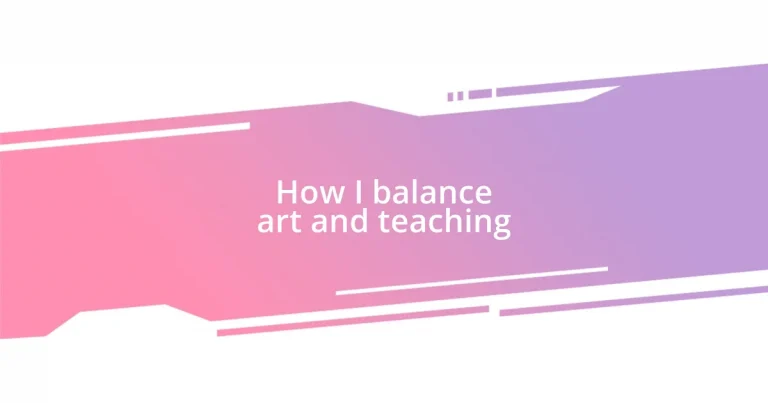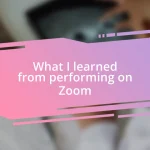Key takeaways:
- Balancing the roles of artist and teacher enhances both personal creativity and student engagement, requiring effective time management and clear boundaries.
- Incorporating art into lessons transforms the classroom atmosphere, fosters collaboration, and allows students to express understanding in diverse ways.
- Continuous evaluation and adaptation of teaching methods based on student feedback is essential for maintaining enthusiasm and engagement in art-integrated learning.
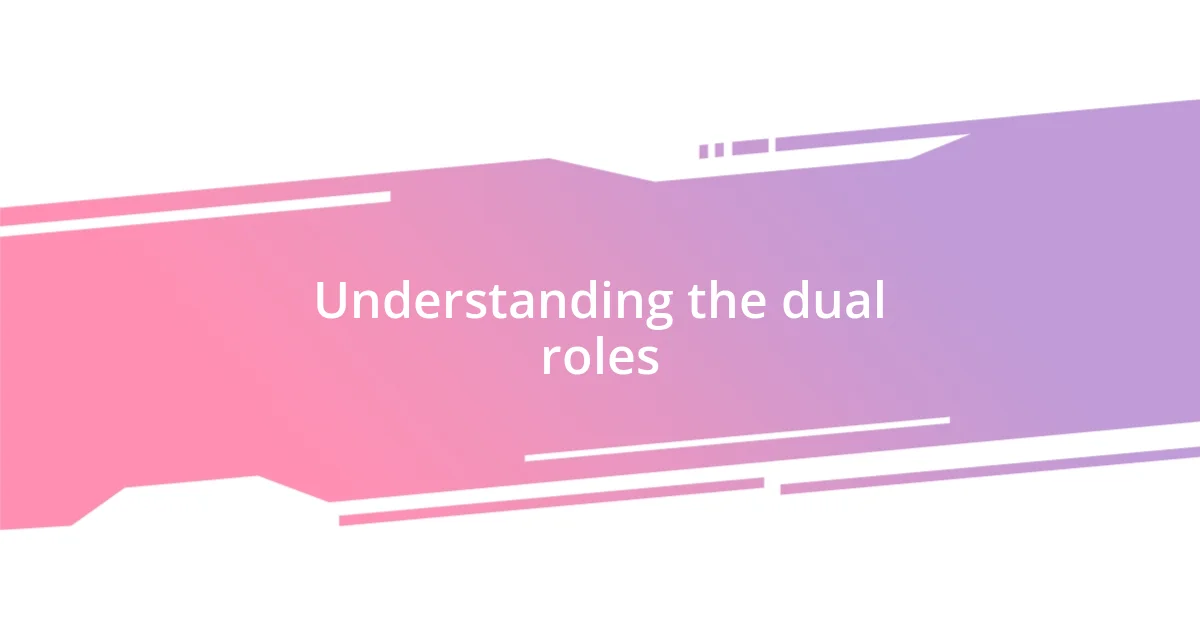
Understanding the dual roles
Balancing the roles of an artist and a teacher can sometimes feel like walking a tightrope. I remember a particular moment when I was preparing for an art show while simultaneously grading student projects. In those frantic hours, I couldn’t help but wonder: how can I fully invest in my art while making sure my students feel valued and inspired? It’s a constant juggling act, and I often find that each role enhances the other.
Exploring my creativity in the studio impacts the way I engage with my students. When I use my personal artistic experiences to inform my lessons, it creates a richer learning environment. I once shared my struggles with a challenging painting technique during a class, allowing students to see not just my successes but also my frustrations. This vulnerability fostered a sense of connection, and I could see the spark of inspiration ignite in their eyes.
Yet, there are days when the weight of my responsibilities can feel heavy. Finding time to nurture my creative side often requires conscious effort and prioritization. Have you ever felt that pressure to create when there are so many demands pulling you in different directions? By setting boundaries and allocating specific times for both artistry and teaching, I’ve discovered that embracing these roles can coexist harmoniously instead of competing for my attention.
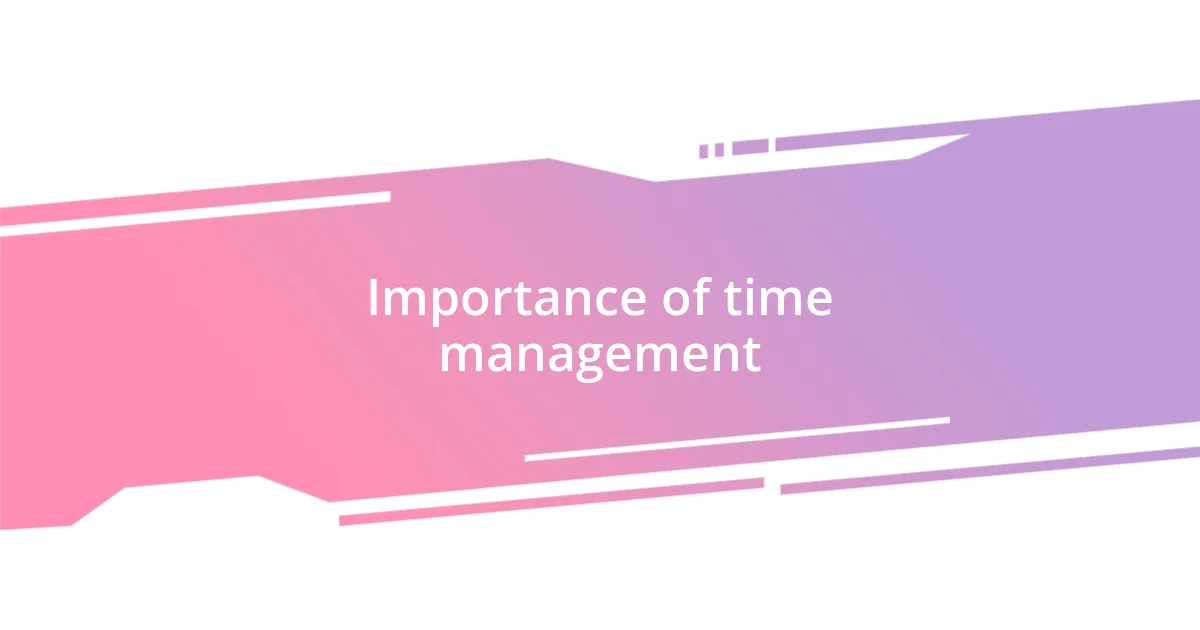
Importance of time management
Managing time effectively is crucial when balancing the demands of art and teaching. I discovered early on that without a solid plan, I felt like I was constantly racing against the clock. There was a chaotic week when I had an exhibition opening just as mid-terms were approaching. I learned the hard way how vital it is to carve out dedicated time for each responsibility, ensuring I’m present both in my studio and in the classroom.
Here are a few strategies that have helped me manage my time:
- Set clear goals: I outline what I need to achieve for both art projects and lesson plans at the start of each week.
- Create a schedule: Blocking out specific times for teaching tasks and creative work keeps me focused and accountable.
- Eliminate distractions: During dedicated art time, I turn off notifications and create a clean workspace to foster creativity.
- Prioritize tasks: I often tackle the most demanding projects first when my energy is highest.
- Reflect and adjust: At the end of each week, I review what worked and what didn’t, making changes as needed for the next week.
Through trial and error, I’ve seen that time management isn’t just about productivity; it’s about making space for the joy of creation and the fulfillment of teaching. That awareness allows me to honor both passions, ensuring I don’t lose sight of why I love doing what I do.
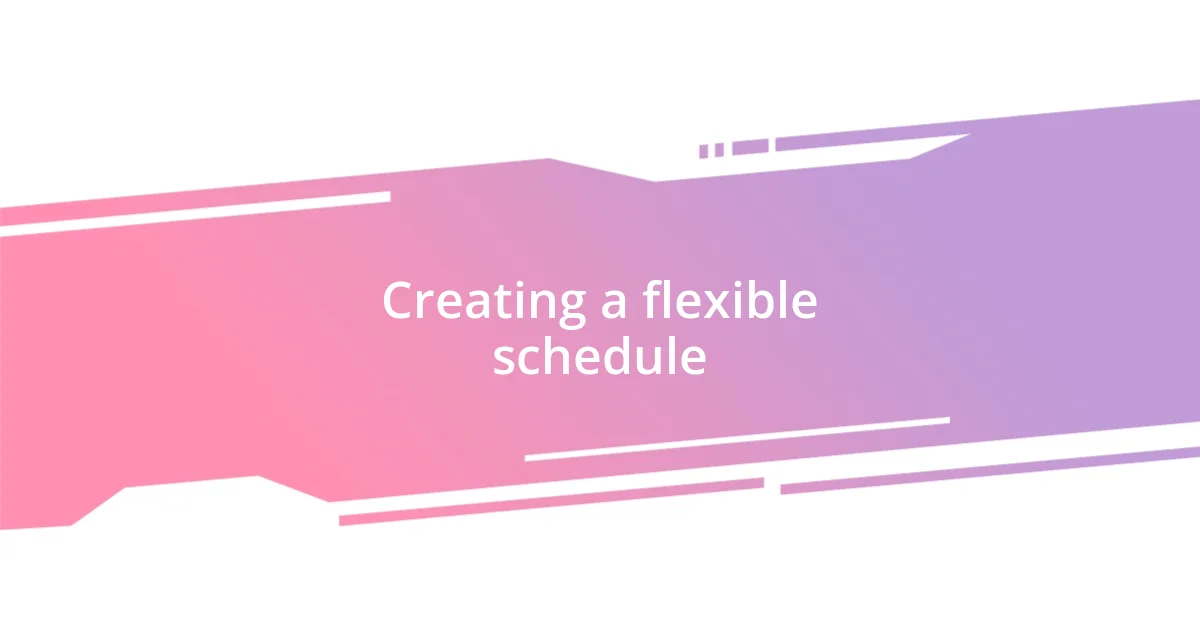
Creating a flexible schedule
Creating a flexible schedule is essential for me to juggle art and teaching smoothly. If I don’t have a clear game plan, I risk letting one passion drown out the other. For instance, I remember the time I decided to dedicate early mornings exclusively for my painting. It felt liberating to have those quiet moments to dive into my creativity without interruptions. Yet, those hours also required discipline; I had to resist the urge to catch up on grading instead.
Having flexibility in my schedule means I can adjust my focus as needed. On particularly busy teaching days, I may have to pivot my time from art to prep work. I recall a day when a last-minute curriculum change demanded my attention. Thanks to my adaptable time management, I was able to shift my painting sessions to the weekend without feeling overwhelmed. Sometimes, just rearranging your week can transform stress into a productive flow.
Creating a visual representation of my schedule has been a game-changer. I use color-coded blocks to differentiate between teaching and art, providing a quick glimpse of my day. By seeing it laid out, I can easily spot gaps for spontaneity — like when inspiration strikes, or I need to recharge. Have you tried visually organizing your time? I find it exceptionally motivating to see my passions side by side, ready for me to dive into them!
| Strategy | Description |
|---|---|
| Dedicated Time Blocks | Set specific hours for art and teaching tasks to create a routine. |
| Adjustable Goals | Revise weekly goals based on what feels necessary and achievable. |
| Visual Scheduling | Use color-coded calendars or planners to differentiate roles and responsibilities. |
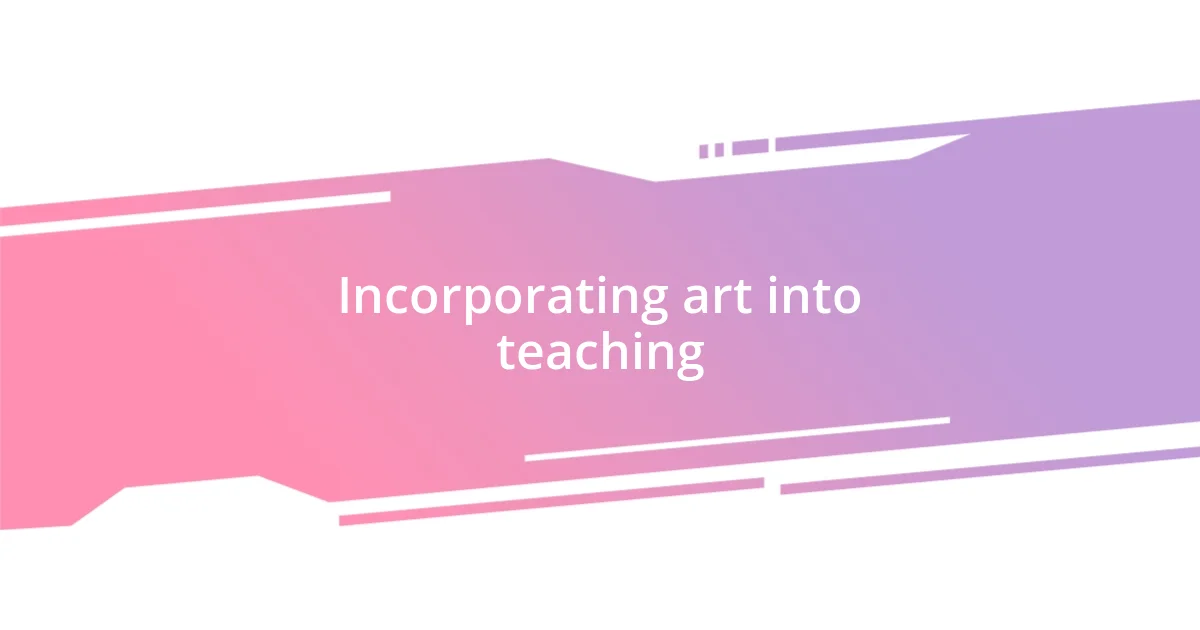
Incorporating art into teaching
Incorporating art into teaching has transformed my classroom into a more vibrant space. I often start my lessons with a short artistic activity, like a quick sketch or a collage, to spark creativity and set a positive tone. It’s fascinating how a simple creative warm-up can shift my students’ moods, making them more engaged and receptive to learning. Have you ever noticed how creativity can lighten the atmosphere?
I remember one lesson where I combined a history topic with an art project, asking my students to create visual timelines of specific events. The room buzzed with excitement as they cut, pasted, and colored their narratives. This approach not only deepened their understanding but also allowed them to express their interpretations uniquely. Seeing those timelines decorated with their personal touches brought a sense of ownership to their learning. It’s moments like these that reinforce my belief in the power of creativity in education.
I’ve also found that using art as a tool for assessment can be incredibly revealing. Instead of relying solely on traditional tests, I’ve given students opportunities to express their knowledge visually. This shift encourages a broader range of skills and insights to come to light. When I see a student who struggles with writing but excels in creating a compelling visual representation of concepts, it highlights their strengths in unexpected ways. Doesn’t it make you rethink the potential of blending these disciplines? Art can bridge gaps in understanding while making learning more enjoyable.
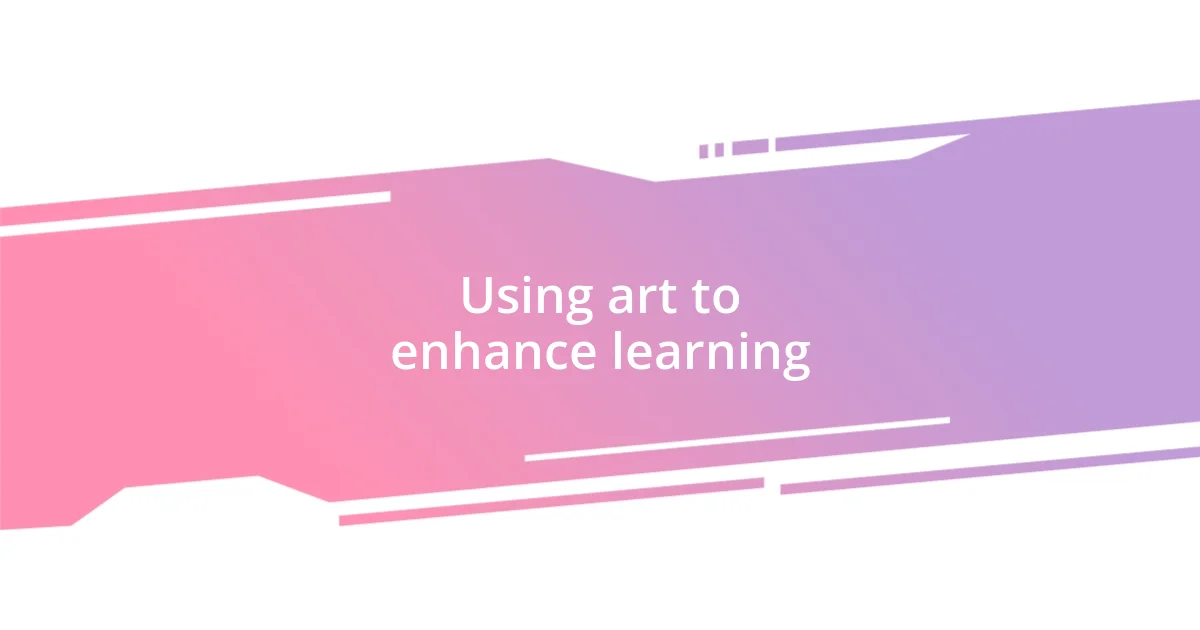
Using art to enhance learning
Art has an incredible power to enhance learning, and I’ve witnessed it firsthand. During one science lesson, I had my students illustrate the water cycle through a comic strip. The giggles and chatter were infectious as they created characters representing evaporation and precipitation. It’s amazing how much they absorbed—not just the steps of the cycle, but also the interactions and significance of each stage. Their artistic interpretations sparked conversations I never expected, revealing deeper connections to the material. Isn’t it fascinating how a bit of creativity can unlock understanding?
I’ve also noticed that art fosters collaboration among my students. One afternoon, I organized a mural project where small groups worked together to depict ecosystems. As they painted, they discussed their ideas, shared opinions, and applied what they’d learned. The collaboration was a beautiful symphony of voices, and I could see them stepping beyond individual homework assignments into a shared vision. These moments don’t just build community; they construct a richer learning experience where they draw strength from each other. Have you ever experienced a transformation in teamwork like that?
When I integrate art into assessments, I often see a shift in student confidence. For example, one student, who traditionally struggled with standardized tests, shone when asked to create a visual representation of a complex topic in math. The joy on her face as she explained her artwork was evident. I could feel that sense of pride washing over her, and it made me realize that art allows students to showcase their understanding in ways we often overlook. It’s a beautiful reminder that learning doesn’t always have to fit into conventional molds—sometimes, it flourishes outside the lines.
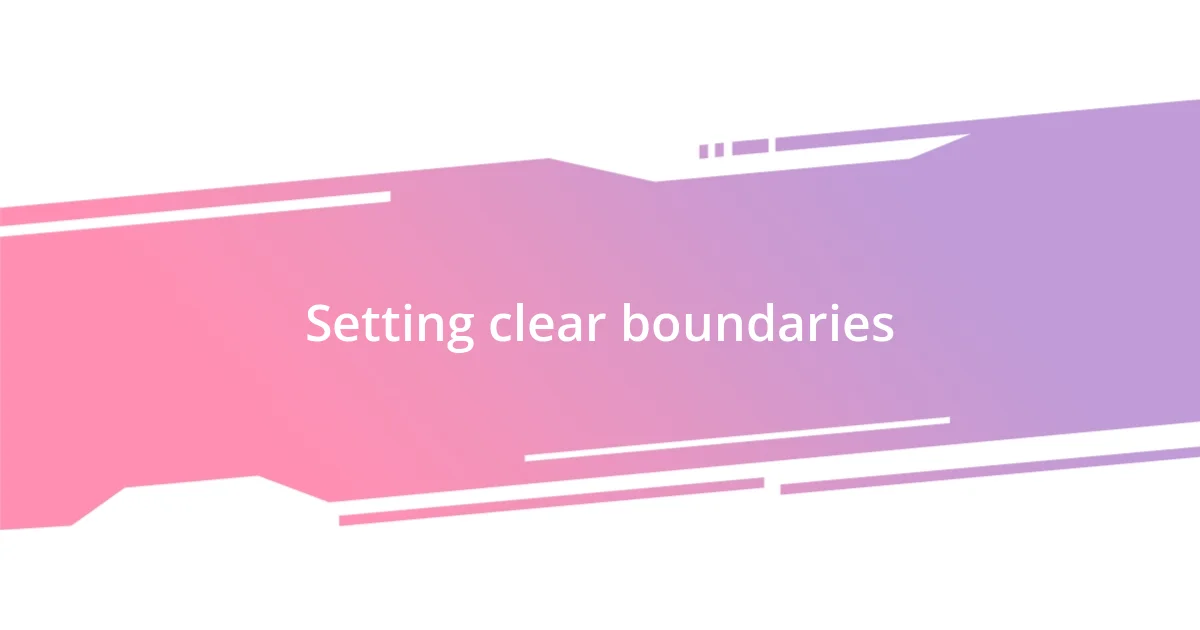
Setting clear boundaries
Setting clear boundaries is essential for maintaining balance between art and teaching in my experience. I’ve learned that defining specific times for creative projects helps prevent the chaotic blending of subject areas that can often feel overwhelming. For instance, I dedicate Fridays to purely artistic endeavors, allowing my students to look forward to these sessions without the pressure of losing track of their academic progress. Isn’t it refreshing to create designated spaces for different aspects of learning?
One technique that really resonates with me is communicating these boundaries to my students. I often share my thoughts on why it’s important to have a clear separation between art projects and core subjects. This dialogue not only sets expectations but also empowers them to manage their time effectively. The day I explained how a structured week could enhance our artistic explorations, I noticed a shift in their understanding; they began to appreciate that creativity also needs its own structure. Have you ever seen the relief on a student’s face when they realize that organization leads to more enjoyable experiences?
I also prioritize personal boundaries, carving out time for my own artistic pursuits outside of teaching hours. It’s vital to recharge creatively so I can bring my best self to the classroom. I remember a particularly busy week where I neglected my art practice, and I felt the energy draining from my lessons. That experience reminded me that to inspire others, I must first nurture my own creativity. Don’t you think our passion for our crafts can rejuvenate the learning process? Balancing my roles allows me to be more present, which ultimately enriches my students’ experience.
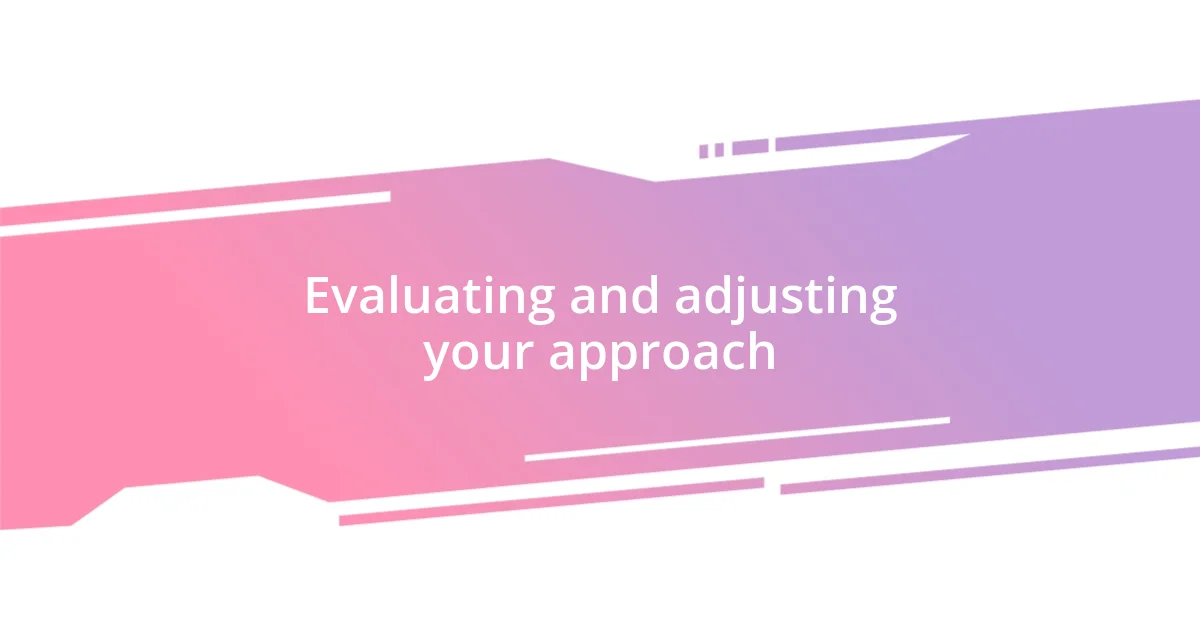
Evaluating and adjusting your approach
Evaluating and adjusting my approach is a continuous journey that provides valuable insights into what truly works in my classroom. Recently, after noticing dwindling enthusiasm in my art-integrated lessons, I took a step back to reflect. It struck me that I was relying too heavily on the same techniques without allowing room for innovation. So, I invited my students to share their thoughts on the projects we were implementing. Their feedback was enlightening; they craved more variety and a chance to express their own artistic styles. This dialogue not only reignited their passion but also reminded me that flexibility is key to sustaining engagement.
Sometimes, I find it necessary to evaluate whether my methods align with my goals for integrating art. Last semester, I experimented with a new art technique during our history lessons. While it was fun, I noticed that students were struggling to connect the artistry with the historical context. I took that as a cue to adjust my approach. By revisiting the lesson structure and intertwining storytelling with the art activity, I created a more cohesive and enriching experience. Have you ever felt that urge to pivot your teaching style in response to your students’ needs? That instinct is so powerful!
I also believe in the importance of tracking progress and being open to change. At the end of each unit, I conduct informal check-ins where students reflect on what worked for them. This approach not only gives me insights into the effectiveness of my art integration, but it also fosters a growth mindset among my learners. I recall a moment when a student shared how a particular project had changed their perspective on a scientific concept. That kind of feedback reaffirms my belief in the dynamic nature of teaching. Isn’t it exhilarating to see your students evolve through their artistic expression? Our willingness to adapt plays a crucial role in nurturing their growth and creativity.












